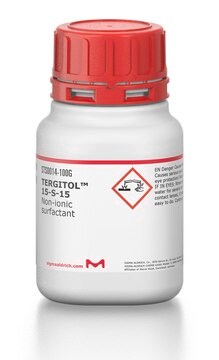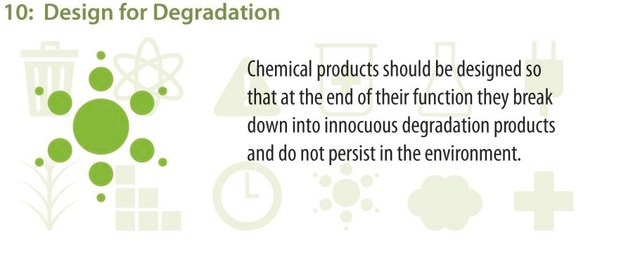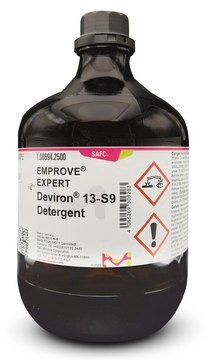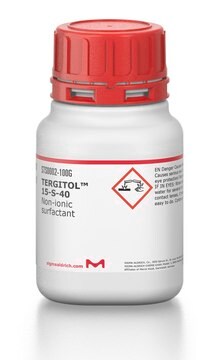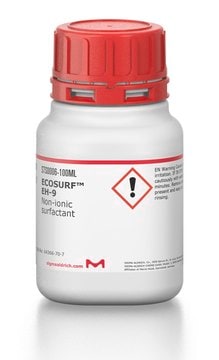Recommended Products
description
non-ionic
Quality Level
type
Type 15-S-9
form
liquid
mol wt
596 g/mol
greener alternative product characteristics
Design for Degradation
Learn more about the Principles of Green Chemistry.
CMC
52 ppm
transition temp
cloud point 60 °C
pour point 9 °C
HLB
13.3
greener alternative category
Looking for similar products? Visit Product Comparison Guide
General description
Tergitol™ 15-S-9 is a linear non-ionic surfactant that is a secondary ethoxylated alcohol. This clear liquid surfactant is compatible with anionic, cationic, and other nonionic surfactants.
Application
- To synthesize thermally stable mesoporous alumina
- To synthesize porous TiO2
- Along with SDS, ethanol and water for continuous phase preparations in electrospray emulsification
- In the synthesis of Lath-like γ-alumina and boehmite nanofibers
Features and Benefits
- Superior detergency
- Rapid dissolution & good rinseability
- Excellent formulation & handling properties
- Narrow gel range
- Readily biodegradable (OECD 301E)
- Low odor
Other Notes
Legal Information
Signal Word
Danger
Hazard Statements
Precautionary Statements
Hazard Classifications
Acute Tox. 4 Inhalation - Acute Tox. 4 Oral - Eye Dam. 1 - Skin Irrit. 2
Storage Class Code
10 - Combustible liquids
WGK
WGK 3
Flash Point(F)
469.4 °F - open cup
Flash Point(C)
243 °C - open cup
Personal Protective Equipment
Certificates of Analysis (COA)
Search for Certificates of Analysis (COA) by entering the products Lot/Batch Number. Lot and Batch Numbers can be found on a product’s label following the words ‘Lot’ or ‘Batch’.
Already Own This Product?
Documents related to the products that you have purchased in the past have been gathered in the Document Library for your convenience.
Difficulty Finding Your Product Or Lot/Batch Number?
How to Find the Product Number
Product numbers are combined with Pack Sizes/Quantity when displayed on the website (example: T1503-25G). Please make sure you enter ONLY the product number in the Product Number field (example: T1503).
Example:
Additional examples:
705578-5MG-PW
PL860-CGA/SHF-1EA
MMYOMAG-74K-13
1000309185
enter as 1.000309185)
Having trouble? Feel free to contact Technical Service for assistance.
How to Find a Lot/Batch Number for COA
Lot and Batch Numbers can be found on a product's label following the words 'Lot' or 'Batch'.
Aldrich Products
For a lot number such as TO09019TO, enter it as 09019TO (without the first two letters 'TO').
For a lot number with a filling-code such as 05427ES-021, enter it as 05427ES (without the filling-code '-021').
For a lot number with a filling-code such as STBB0728K9, enter it as STBB0728 without the filling-code 'K9'.
Not Finding What You Are Looking For?
In some cases, a COA may not be available online. If your search was unable to find the COA you can request one.
Related Content
An overview of cell lysis and protein extraction methods including detergent solubilization, freeze-thaw lysis, osmotic shock, sonication, enzymatic cell lysis, and mechanical disruption techniques such as Dounce, Polytron, and mortar and pestle homogenization.
An overview of cell lysis and protein extraction methods including detergent solubilization, freeze-thaw lysis, osmotic shock, sonication, enzymatic cell lysis, and mechanical disruption techniques such as Dounce, Polytron, and mortar and pestle homogenization.
Our team of scientists has experience in all areas of research including Life Science, Material Science, Chemical Synthesis, Chromatography, Analytical and many others.
Contact Technical Service